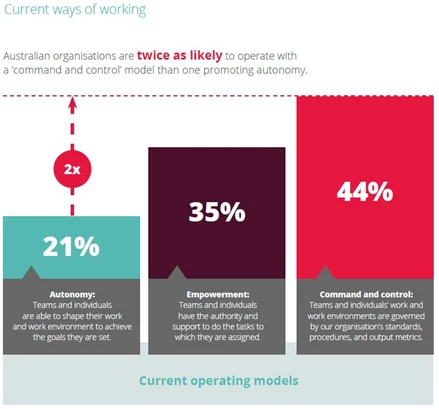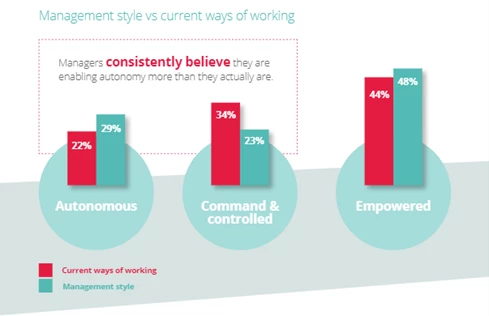
Our relationship with technology has probably changed more in the last two years than it had in the previous decade. Despite the terrible circumstances, COVID-19 has given many businesses the push they needed to reframe their relationship with technology, enable their teams to connect (anywhere, anytime), and fundamentally change the way we live, work and play.
It means now is a better time than ever to explore our current ways of working and what an ideal workplace might look like. For decades, we have heard that ‘empowering’ employees is the key to greater productivity and job satisfaction. Yet is empowerment just another form of control? As Daniel Pink, bestselling author and former speechwriter for Al Gore, puts it: “the notion of empowerment presumes that the organisation has the power and benevolently ladles some of it into the waiting bowls of grateful employees.”
We recently set out to discover whether Australians truly feel empowered at work. And if they do, is this empowerment enough - or do we want more freedom and autonomy in the way we do our jobs?
Our research – ‘Autonomy to the People’ – analyses employees’ demands for autonomy, the current state in which organisations work, and management styles of leaders in the Australian workforce. We always suspected that giving people the autonomy they want would be good for business, but perhaps this study finally proves it…
Employees want more autonomy than they currently have
We found there is an apparent disconnect between how organisations operate and how people want them to. The vast majority of organisations operate with either empowerment or top-down command-and-control models. Yet respondents to our study were more likely to choose the autonomous model as their ‘ideal overall state’ than either the empowered or controlled model.

This was further apparent when we examined organisational and management behaviours in more detail. Empowering and controlling behaviours are more common than autonomy-enabling traits, such as allowing teams and individuals to shape their work and work environment to achieve their goals. Furthermore, managers consistently believe they are enabling autonomy more than they actually are within their organisation.
Against this context, employees want more autonomy in several specific areas. The respondents believe that they do their best work when they have a clear idea of managers’ expectations of them, an understanding of the organisation’s strategic direction and goals, and self-determination over where and when to do the task. Combine these traits with managers who provide guidance rather than micromanage or rely on rigid processes, and employees feel they can be most effective.
Unsurprisingly, our desire for more autonomy in our work lives has increased since the onset of the pandemic. Respondents believe all the ingredients for autonomous ways of working are significantly more important to their organisation than before COVID-19 struck. It’s clear the pandemic has proven what most of us currently experience: autonomy must play a significant role in the way in which we now work.
Autonomy is good for business
So why is the autonomous approach so favourable to the respondents, and what does it imply for organisations? The study found a strong business case for greater freedom. Autonomy is seen as the best way for organisations to achieve results such as innovation, customer and employee experience, and organisational agility.
While Australian organisations are doing a fine job at empowering their employees, there is still a gap that needs to be bridged between the current and ideal state. Leaders must do more to meet employee expectations, enabling employees to control important aspects of their work lives, sharing information, data and insights to help them do their jobs, and adopting oversight styles based on outcomes rather than inputs.

This view of autonomy is particularly relevant given the fluid nature of our work as individuals and organisations transition between various restrictions. Up to now, discussion about new ways of working has centred on where employees should work, and if and when we see conditions for a mass return to on-site working. Location is important - and essential in some industries - but our view is the ‘workplace’ becomes less critical to an organisation’s success than the ‘workspace’ that enables effective autonomy.
We believe if teams can align on a shared goal, cognisant of their organisation’s objectives and context, and access the data and resources they need, leaders can feel confident in giving them the autonomy to do the best possible job. Individuals and organisations alike will get the benefits.
Discover more insights about the demand for autonomy, how it is good for business, and why leaders should adopt these behaviours to enable greater Autonomy to the People.